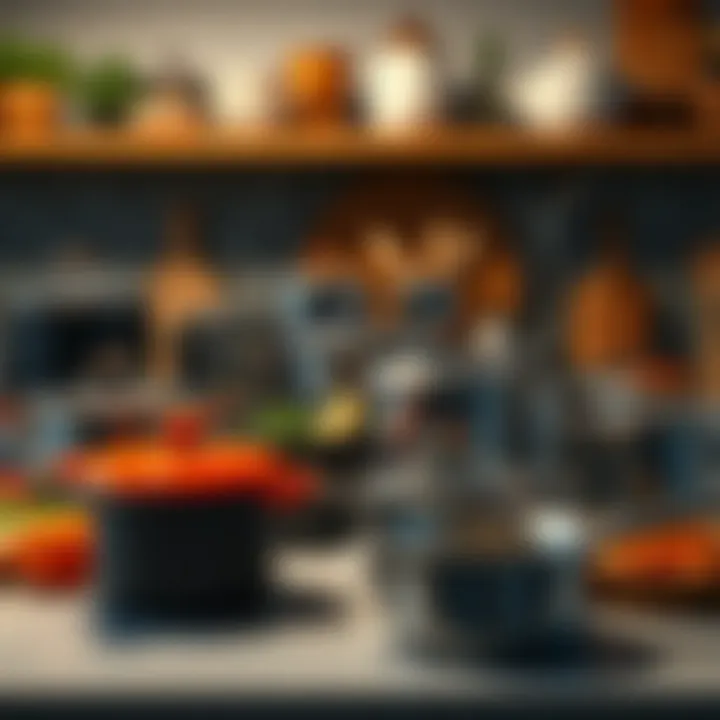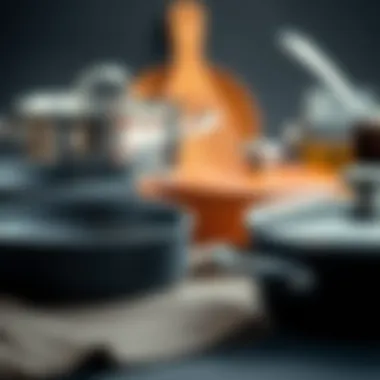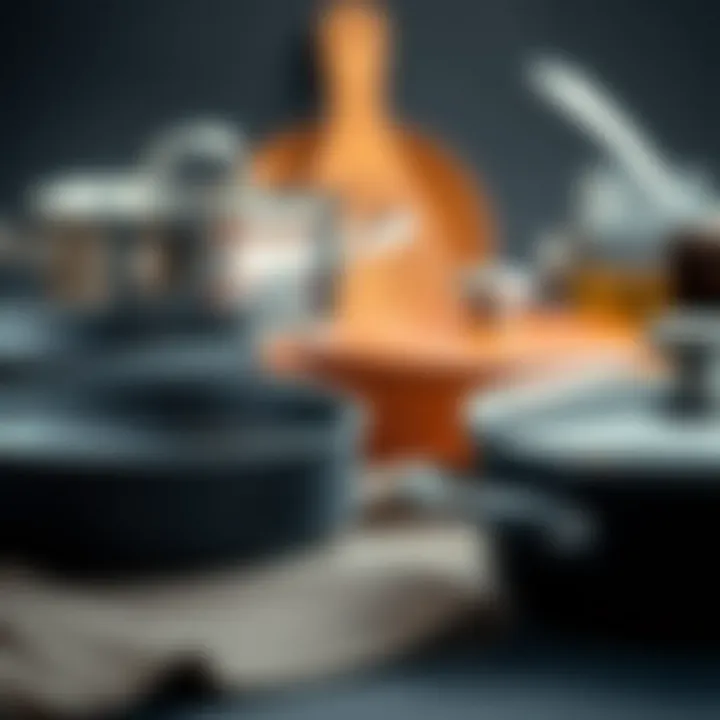Comprehensive Guide to Kitchen Pot Sets for Every Cook


Intro
When it comes to the heart of any kitchen, pot sets often take center stage. They are not just mere tools; they embody the essence of cooking, enabling culinary creations that can warm the soul and delight the senses. Selecting the right pot set can feel overwhelming, given the plethora of options available. But fret not! This guide aims to break down the necessary components to consider, allowing you to meticulously choose a collection that stands up to your cooking habits and enhances your kitchen's aesthetic.
In today’s culinary landscape, pot sets come in a variety of materials and designs, catering to both the casual cook and the dedicated culinary artist. From stainless steel to cast iron, and every material in between, understanding the fine details and nuances is vital. Moreover, it’s essential to recognize that a well-chosen set can elevate not just your cooking and efficiency, but also your enjoyment in the kitchen.
This guide will comprehensively explore:
- Different types of pot sets available on the market
- Key considerations when selecting your cookware
- Care and maintenance tips to prolong your pots’ life
- Current trends in cookware
- Innovative uses and how to maximize the utility of your pot set
At the core of this exploration is the aim to equip you with the knowledge necessary to make informed decisions. Whether you are an aspiring chef or a kitchen novice, understanding the variations and specifics of pot sets will ultimately contribute to a more fulfilling cooking experience.
Why the Right Pot Set Matters
Choosing the right pot set matters more than just aesthetic appeal. High-quality pots can have a significant impact on heat distribution, cooking times, and ultimately, the taste of your dishes. Investing in a set that meets your needs can drastically improve your culinary creations, bridging the gap between mediocre and masterful cooking.
Moreover, with the right information at hand, you'll be better prepared to select pots that complement your personal style and enhance your kitchen’s decor. Cooking can be a cherished element of daily routine, so why not elevate it with the best tools available? With this guide in hand, you'll dive into a world of knowledge that empowers your kitchen endeavors, giving you both confidence and convenience.
Prelims to Kitchen Pot Sets
When you step into a kitchen, what do you see? Besides the delightful chaos of spatulas and ingredients, the kitchen pot sets often take center stage. They are not mere tools; they’re the backbone of culinary endeavors. But why do kitchen pot sets matter so much? Well, their significance goes beyond just boiling water or simmering sauces.
The right pots can really transform your cooking, impacting not just the taste of your meals, but also the overall experience of creating them. A good set has the ability to distribute heat evenly, making sure that your dish cooks perfectly, whether you're whipping up a simple pasta or a complex stew. When it comes to selecting the perfect pot set, there are plenty of factors to consider.
Durability is key. High-quality materials ensure that your investment lasts for years, standing up to daily use and tough cleaning. You wouldn't want a flimsy pot that warps after a few uses. Then, there's versatility; different cooking styles require different pots—what works for a slow-cooked dish may not suffice for sautéing.
Of course, the aesthetic aspect cannot be ignored. A well-chosen set can elevate your kitchen's decor and add a touch of style. You might care about how your cookware looks hanging on display.
Additionally, understanding various types and materials helps in making an informed decision. Each pot serves its purpose, from the heavy stockpot that can handle a hearty soup to the sleek frying pan for quick morning omelets.
"A kitchen without pots and pans is like a chef without knives."
Understanding kitchen pot sets also means appreciating the benefits they provide. They contribute to efficiency in cooking, saving you time and reducing stress while preparing meals. Imagine knowing that your pots are reliable and up to the task, letting you concentrate on the recipe rather than worrying about equipment.
As we delve deeper into this comprehensive guide, we will explore different pot types, the materials they're made from, and other key considerations. This will empower both novice cooks and seasoned chefs to make choices that complement their cooking style. In the end, the quest is to find that perfect pot set that not only meets your culinary needs but also enhances your cooking experience.
Understanding Different Types of Pots
Understanding the various types of pots is essential in making informed decisions about your kitchen pot set. Each pot serves a specific culinary purpose, and knowing which one to use can greatly affect the quality of your dishes. It is not just about having the right shapes and sizes but also about choosing pots that complement your cooking style.
Choosing the right pot can save time and enhance your efficiency while cooking. For instance, if you frequently prepare large quantities of soup or stew, knowing the characteristics of a stockpot versus a saucepan becomes pivotal. With each pot offering unique features, being familiar with these elements allows you to maximize your cooking experience.
Saucepan
The saucepan is a versatile piece of cookware that can handle a variety of tasks—simmering sauces, boiling vegetables, or even making small batches of soups. Typically, a saucepan comes with a wide base, tall sides, and a lid, which is ideal for regulating liquids and preventing splattering. Sizes can range from 1 to 4 quarts, allowing for a number of cooking applications.
One significant advantage of a saucepan is its ability to conduct heat evenly, especially if made from copper or stainless steel. This characteristic helps in preventing hot spots, resulting in optimal boiling and simmering.
In culinary practices, using a saucepan can also enhance the flavor profiles of your dishes. For example, when making a reduction sauce, the wide opening encourages evaporation, intensifying the flavors remarkably.
Stockpot
A stockpot is larger and deeper than a typical saucepan, designed for making stocks, broths, and boiling large portions of ingredients. The size often ranges from 6 to 20 quarts. If you love to entertain or have a large family, a stockpot is invaluable for preparing hearty soups or seafood boils.
An important consideration for stockpots is their material. Heavy-duty stainless steel works great, but many opt for aluminum for its excellent heat conduction. The strong, sturdy handles simplify lifting a heavy pot filled with liquid, which is a game-changer when making that rich beef broth or jumbo batch of chili.
Imagine discovering a new recipe for a fabulous gumbo. Without a proper stockpot, preparing such a dish can quickly turn into a juggling act between multiple pans.
Dutch Oven
Dutch ovens are a cook's best friend, especially for those who adore slow cooking and one-pot meals. These pots, often made from cast iron or enameled cast iron, feature thick walls and a tight-fitting lid, allowing for moisture retention and even heat distribution.
Their inherent versatility is noteworthy. Whether you're baking bread, braising meats, or crafting a slow-cooked stew, a Dutch oven can handle it all on the stovetop or in the oven. With sizes typically ranging from 2 to 7 quarts, you can adjust based on the number of servings you need.


Moreover, a well-maintained Dutch oven can last generations, making it a worthy investment for any culinary enthusiast. Frequently passed down through families, these pots carry stories of delightful meals and special occasions.
Frying Pan
Different from a skillet, a frying pan features a shallow, wide base and slightly flared sides, making it the go-to for quick cooking methods such as frying, searing, or browning. Generally, pans can come in a range of materials, including stainless steel, nonstick, or cast iron.
The nonstick frying pan is perfect for delicate items like eggs or fish, as it minimizes the chances of sticking and breaking apart. Conversely, a well-seasoned cast iron frying pan can add flavor while providing excellent heat retention—all excellent qualities when searing a steak.
In the world of sautés, the right frying pan can mean the difference between dinner-time disaster and culinary triumph. Mastering the sear on a piece of meat could transform an ordinary dish into something extraordinary, opening your kitchen to fresh possibilities.
By familiarizing yourself with the different types of pots, you empower your cooking adventure, allowing for creativity to flourish and ensuring that each meal resonates with the love and attention it deserves.
Material Matters: Comparing Pot Types
When diving into the world of kitchen pot sets, the material used in their construction is pivotal. Your choice affects not just the cooking performance but also the longevity and ease of maintenance of your pots. Different materials offer unique advantages and draw backs, shaping how you cook and what dishes you can create.
Below, we’ll take a closer look at some of the common materials used in pot sets—stainless steel, cast iron, non-stick, and copper—to help you make a well-informed decision based on your cooking style and preferences.
Stainless Steel
Stainless steel pots are quite popular. They’re known for their durability and resistance to rust and corrosion. One of the major perks of stainless steel is its ability to withstand high temperatures without warping. This makes it ideal for browning meat or for any cooking technique requiring high heat. Moreover, a key feature is that it doesn’t react with acidic or alkaline foods, ensuring that dishes retain their flavor.
- Maintenance: Simple to clean, just a little soap and water go a long way.
- Versatility: Great for various heat sources, including induction.
- Price Range: Affordable options are available, but high-end products can be pricey depending on the quality.
The only downside might be the tendency for food to stick if not prepped correctly, especially delicate foods like fish.
Cast Iron
If you're after traditional cooking and superior heat retention, cast iron is the way to go. These pots require a bit more love and care, but the flavor they develop over time is unmatched. Cast iron is the go-to for braising, frying, and baking, including that famous cornbread.
- Durability: With proper care, cast iron can last a lifetime, often being passed down through generations.
- Heat Distribution: Even heating makes it perfect for slow cooking.
- Seasoning: Requires regular seasoning to maintain its non-stick property and to prevent rusting.
Some might find the heavy weight a bit of a hassle, especially when lifting or maneuvering.
Non-stick
Ah, the joy of non-stick pots! Perfect for quick meals and easy cleanup, non-stick cookware is a favorite among busy cooks. These pots are coated with a substance that prevents food from sticking, making them ideal for cooking breakfast eggs or tossing together a stir-fry without worrying about messy aftermath.
- Convenience: Just wipe clean—no stubborn bits stuck to scrub off.
- Health Factor: Requires less oil for cooking, ideal for those watching their fat intake.
- Color Options: Often available in an array of colors and designs, adding flair to your kitchen.
However, they do have downsides. The non-stick coating can wear off over time, and they often can’t withstand high heat like some other materials.
Copper
Copper pots are a staple in many professional kitchens, revered for their superior heat conductivity. They heat up quickly and respond to temperature changes faster than other materials, bringing the best out of your culinary skills—especially in delicate cooking methods like making sauces.
- Aesthetic Appeal: A visual delight, copper pots can elevate the look of your kitchen.
- Responsive Heat: Perfect for precise cooking tasks.
- High Price Point: Usually more expensive than other options, reflecting their quality and craftsmanship.
On the flip side, copper requires more maintenance; it needs polishing to keep its shine and often requires a special lining (like stainless steel) to prevent reactions with certain foods.
Remember, the right pot material can make all the difference in the kitchen. Choose wisely to ensure that it fits your cooking habits and enhances your culinary creations!
Size Considerations for Pot Sets
When it comes to pot sets, size matters more than you might think. The dimensions of your cookware can greatly influence both functionality and storage. Choosing the right size set can enhance efficiency in meal preparation and ensure that your cooking experience is as smooth as silk.
Small Sets for Limited Spaces
If your kitchen is a bit more cramped than a sardine can, opting for a small pot set could be your best bet. These sets typically include just a few key pieces that cover the essentials: perhaps a saucepan, a frying pan, and a dutch oven. The beauty of these smaller sets lies in their adaptability—they can be stored easily in cabinets or drawers without much fuss.
In a cozy kitchen, a compact set allows you to whip up meals without sacrificing counter space. They fit snugly, making cleanup a breeze too. A great example is the T-fal Initiatives Soft Grip Cookware Set, which includes a frying pan and a saucepan—all in sizes suitable for small servings. This just goes to show that small can indeed pack a powerful punch.
Complete Sets for Versatility
Now, if you like to spread your culinary wings, a complete pot set is the way to go. These sets often include a mix of various pot sizes, frying pans, and sometimes even specialty items like steamer inserts. This versatility means you can tackle everything from simmering sauces to preparing a full-blown feast.


Think of a complete set as your kitchen’s Swiss Army knife—ready for any cooking task. Brands like Cuisinart 77-11G Chef’s Classic Stainless Steel Set offer a comprehensive selection that lets you prepare diverse dishes. With different sizes at your disposal, you can efficiently cook multiple items at once, saving time and energy in the kitchen.
Professional Sets for Serious Cooks
For those who take their cooking seriously, investing in a professional set can be a game changer. These sets come equipped with precision-engineered pots and pans that cater to a range of cooking techniques, whether you’re searing, braising, or baking.
A prime example is the All-Clad D3 Stainless Steel Cookware Set, favored by many culinary professionals. This set is designed to withstand high heat, ensuring even cooking and top-notch responsiveness. Professional sets are generally larger and more robust, meaning they can handle the rigors of extensive cooking. When picking a pot set at this level, consider your cooking style and storage capabilities, so you're not left regretting your purchase later on.
"The right size pot set can streamline your cooking, making everyday tasks feel less overwhelming and more enjoyable."
Choosing the Right Pot Set for Your Cooking Style
Determining the appropriate pot set for your cooking style isn’t merely about aesthetics or brand adherence. Rather, it's about aligning the cookware with your culinary habits and preferences. Each individual brings unique flavors and techniques to their kitchen, and the pot set you choose can either support or hinder that creativity. This section dives into how various cooking styles require different pot sets and the factors you should weigh when making your selection.
Everyday Cooking
Everyday cooking is often the heartbeat of any household. It involves stowing away leftovers, whipping up quick meals, or serving up family favorites. Pot sets for this category ought to be versatile and durable. Generally, a trusty non-stick frying pan for pancakes, a sturdy saucepan for boiling pasta, and a sizable Dutch oven for stews would be vital components. When selecting a set, consider:
- Durability: Materials like stainless steel or hard-anodized aluminum can withstand daily use.
- Versatility: A few key pieces can fulfill a variety of cooking tasks.
- Ease of Maintenance: Non-stick surfaces or dishwasher-safe options will save kitchen time.
Thus, a moderately priced, well-rounded pot set will help make your everyday cooking enjoyable and efficient. Having pots that can transition from stovetop to oven or that come in different sizes will surely be your best cooking partners.
Gourmet Cooking
For those who revel in the fine details of culinary creation, gourmet cooking demands an entirely different set of tools. Here, precision and quality reign supreme, as even the smallest change can affect the dish's outcome. Copper pots or high-quality stainless steel are ideal for such discerning chefs due to their superior heat conductivity and responsiveness. Here's what to look for:
- Temperature Control: Chef-grade pots help manage heat more accurately, which is critical when reducing sauces or tempering chocolate.
- Quality Materials: Invest in pots that resist warping and can handle high heat, keeping their form under pressure.
- Multi-functional Pieces: Consider a Dutch oven that can be used for slow braising and souping or a saute pan with a lid for versatility.
Investing in high-quality cookware is vital for serious cooks. They often become lifelong companions in the kitchen, elevating the entire cooking experience to new heights.
Special Diets and Cooking Styles
In today’s diverse culinary landscape, pots and pans play a pivotal role in accommodating special diets. Whether you are preparing gluten-free, vegan, or low-carb meals, having the right kind of pot ensures that your dishes are not only delicious but also safe for those with dietary restrictions. Key considerations include:
- Material Compatibility: Avoid non-stick coatings if you're cooking for someone sensitive to chemicals. Opt for stainless steel or cast iron instead.
- Size: Depending on portion sizes and meal prep, a smaller pot may be all you need for single servings, while a larger one is necessary when cooking for family gatherings.
- Ease of Cleaning: For busy cooks, pots that are easy to clean can be a lifesaver, especially when dealing with sticky ingredients or leftovers.
The right pot set can support your commitment to a specific dietary approach and ultimately enhance the flavors and textures you achieve in your meals.
To sum up, understanding your cooking style is fundamental in selecting the right pot set. Whether it's making nachos for game night or crafting a Michelin-star-worthy dish, matching your cookware to your culinary needs will pay dividends in the kitchen.
When choosing your pot set, remember that the goal is more than just preparing food. It's about making your cooking experience smoother, enjoyable, and encouraging your creativity, so don’t rush the decision!
Trends in Kitchen Pot Sets
The landscape of kitchen cookware has evolved, reflecting new lifestyles, environmental consciousness, and the rise of technological advancements. In this section, we will explore the latest trends in kitchen pot sets, emphasizing why these trends matter for everyday cooking enthusiasts as well as seasoned chefs. Understanding these trends can help you choose pot sets that not only meet your culinary needs but are also aligned with contemporary values and innovations.
Eco-friendly Options
In today's world, more people recognize the significance of sustainability. When it comes to kitchen pot sets, eco-friendly options have become a priority for many. These pots are often made from materials that are not only durable but also sourced in a way that minimizes harm to the environment. For instance, ceramic pots free from harmful chemicals are gaining popularity. Additionally, bamboo utensils are increasingly paired with such sets, promoting an eco-conscious cooking experience.
Some benefits of choosing eco-friendly pot sets include:
- Longevity: Many eco-friendly materials tend to fare better in terms of longevity, meaning that you might not need to replace them as frequently.
- Healthier Cooking: Natural materials often provide a healthier alternative, particularly for non-stick options that may leach chemicals at high temperatures.
- Less Waste: Investing in sustainable cookware contributes to less waste, appealing to environmentally conscious consumers.
"Sustainable cooking isn't just a trend; it's a lifestyle choice that reflects your values at home."
Smart Cookware
Amidst the rise of technology, smart cookware has started to make waves in kitchens around the globe. Smart pots and pans often contain sensors that assist with cooking, ensuring precision in temperature control and timing. This innovative approach allows chefs to cook with accuracy, regardless of their culinary skill. Some even connect to smartphone apps, allowing users to track their cooking progress remotely, which can free up time for multitasking.
Features of smart cookware typically include:
- Temperature Regulation: Maintains optimal cooking temperatures, which helps in achieving the desired results without constant supervision.
- App Connectivity: Users can receive notifications and guidance through their mobile devices, making cooking more streamlined.
- Energy Efficiency: Many smart cookware options are designed to use energy more efficiently, which can lead to reduced utility costs over time.


With trends like eco-friendliness and smart technology steering kitchenware choices, it’s now possible to elevate your culinary experience while being mindful of your health and the environment. The integration of these two aspects represents a broader shift in consumer behavior that continues to influence kitchen equipment design, usage, and even marketing.
Maintenance and Care for Your Pot Set
Taking care of your cookware, particularly your pot sets, is essential if you want them to last and perform optimally. Many underestimate the importance of maintenance; think of it as a relationship, where consistent care leads to better results. It’s all about extending the life of your pots while ensuring that every meal cooked in them is delightful. This segment will explore key cleaning techniques tailored for different materials, as well as effective storage practices to keep your pots in tip-top shape.
Cleaning Tips for Different Materials
When it comes to cleaning your pots, each material requires a different finesse. Ignoring this can lead to deterioration, reducing their effectiveness and aesthetics.
- Stainless Steel: It’s versatile but can stain. Hot water mixed with baking soda works wonders for stubborn spots. Avoid steel wool, as that might scratch the surface.
- Cast Iron: Less is more here. A sprinkle of coarse salt and a non-abrasive sponge can remove residue, but never use soap – it strips the seasoning. Make sure to dry completely to avoid rust.
- Non-stick: Keep them looking new by using gentle sponges. High heat can warp the coating, so stick to low or medium heat while cooking. For stuck-on bits, soak in warm soapy water before gently scrubbing.
- Copper: A bit trickier, as it tarnishes easily. Use a mixture of vinegar and salt or special copper cleaner to bring back that shine, but avoid abrasive cleaners that can scratch the surface.
Consistently implementing these cleaning tips will not only make your pots look good as new but also preserve their functionality.
Storage Best Practices
How you store your pots can significantly affect their longevity and usability. Here are some practices worth considering:
- Use Dividers: If you stack pots, use soft dividers made of fabric to prevent scratches. Nobody wants those scuffs on their favorite frying pan.
- Hang when Possible: If you have the space, displaying pots on a rack not only saves cabinet space but also gives your kitchen a professional look.
- Keep the Lids Separately: Store lids separately to prevent them from getting damaged. Perhaps consider a lid organizer to keep them accessible and neat.
- Avoid Extreme Conditions: Don’t store pots near heat sources or in damp places. Excessive heat can warp, and moisture can lead to rust.
By following these storage techniques, you’ll prevent the wear and tear that can come from careless stowing. Whether you’re a budding home chef or a seasoned kitchen wizard, you want your tools to last—so treat them right!
A regular cleaning and storage routine can transform your cookware from ordinary to extraordinary. It’s all about giving your pots the care they deserve.
Cost Considerations When Buying Pot Sets
When it comes to pot sets, price plays a significantly pivotal role in the decision-making process. After all, investing in kitchen cookware is not just about choosing the most visually appealing option; it involves evaluating aspects like usage frequency, durability, and the best fit for one’s cooking style. Understanding the financial implications can help consumers avoid buyer's remorse while ensuring they get the best bang for their buck.
Understanding Price Differences
Pot sets come with a wide array of price tags that often correlate with various factors such as material, brand reputation, and included pieces. For instance, premium brands like Le Creuset or All-Clad offer products that sport a hefty price due to their quality craftsmanship and longevity. Conversely, less-known brands provide options that may serve a similar purpose but at a fraction of the cost.
Delving into the price differences also requires attention to how these pots can withstand wear and tear in a busy kitchen environment. For example:
- A stainless steel pot may cost more but could be more resistant to dents and corrosion, providing better value over time.
- On the flip side, a basic non-stick frying pan might seem budget-friendly, but it might also wear out faster, requiring replacement sooner than anticipated.
In essence, when weighing price differences, exploring how frequently you'll use each type of pot can lead to wiser investments. Think of it like planting; some seeds yield a bountiful harvest while others may wither away in poor soil.
Investment vs. Budget Options
Determining between investment pieces or budget-friendly options largely hinges on individual needs and cooking habits.
Investment pieces are often characterized by:
- Longevity: High-end pots can last a lifetime with proper care.
- Versatility: They adapt well to various cooking techniques, making them suitable for both novice and expert cooks.
- Quality Performance: They usually provide even heat distribution, which is essential for consistent cooking results.
In contrast, budget options may include:
- Affordability: Ideal for those just starting or with limited funds.
- Variety: Offers a broader selection of styles and features without emptying one's pockets.
- Ease of Replacement: Perfect for individuals not committed to cooking and who might need frequent product replacements.
Ultimately, the choice boils down to personal cooking ambitions and budget constraints. A well-chosen pot set not only enhances cooking experiences but also stands as a wise financial investment in the long run.
"Always think beyond the price tag; consider what should matter most in the kitchen where flavor and creativity reside."
In this light, it becomes clear that making informed decisions about pot sets affects both immediate satisfaction in cooking and long-term satisfaction with your culinary investments. Careful consideration of your cooking habits and needs can illuminate the path to choosing the right set that is worth every penny.
End: Making an Informed Choice
When it comes to selecting kitchen pot sets, the choices can often seem overwhelming. This article has detailed various pot types, materials, sizes, and even cost considerations. All these factors are paramount to making a well-informed decision.
Understanding your cooking habits is perhaps the most crucial first step. If you often prepare an array of dishes, investing in a versatile set that includes various pot types would be beneficial. On the other hand, if your cooking tends to focus on simpler meals, perhaps a compact set would suffice. All boils down to your personal needs, right?
Additionally, material choice cannot be ignored. As we discussed, every material comes with its own strengths and weaknesses. A seasoned cast iron pot might be ideal for slow-cooking, while a stainless-steel pot could offer excellent heat distribution for everyday meals. Non-stick might be your ally for easier cleaning, but it requires a fair bit of care to maintain its surface.
When making a financial decision, consider not only the upfront costs but also the longevity and maintenance expenses associated with each type. Some pots may seem pricey initially but might last for decades with proper care. Meanwhile, lower-cost options might require replacement much sooner, which can add up in the long run.
Before you finalize your purchase, you might find it helpful to:
- Check customer reviews to gauge user experiences.
- Visit kitchenware blogs or forums like reddit.com/r/Cooking for real-life recommendations.
- Seek insights from culinary aficionados at local cooking classes or online communities.
In the end, making the right choice isn’t just about the pots themselves, but how those pots will enhance your cooking experience. When you take all these elements into consideration, you’re better equiped to select a pot set that not only fills your kitchen shelves but also supports your culinary ambitions. Investing time and effort into this selection process will undoubtedly pay dividends in your kitchen adventures.







